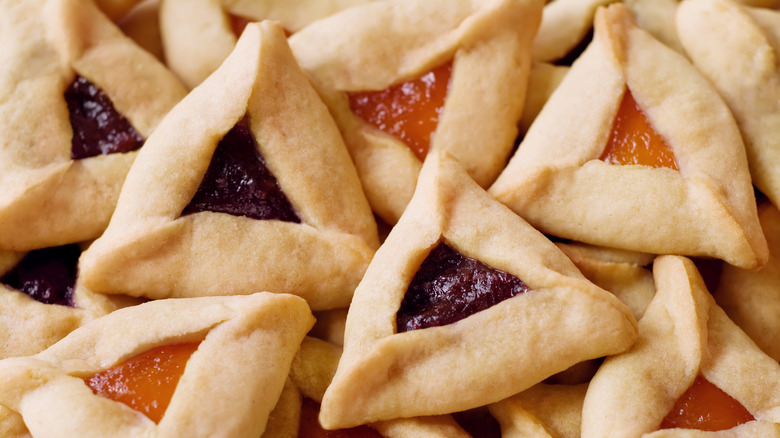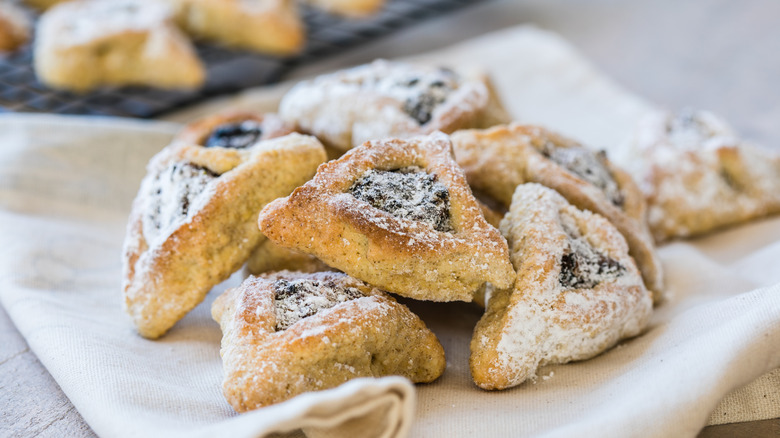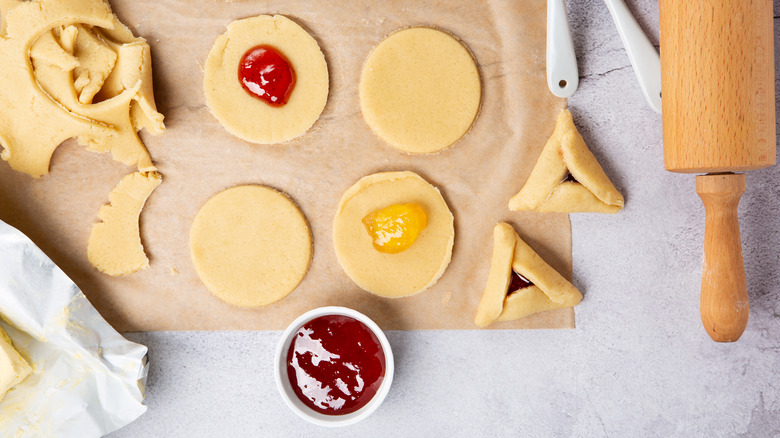Why Purim Hamantaschen Cookies Take The Shape Of A Hat
Food is an important part of many Jewish holidays. Many of these holidays have specific foods that should be eaten in observance, and those foods in turn hold holiday memories for many Jewish people. The Jewish holiday of Purim begins on March 6 at sundown and ends at sundown the following day, March 7. The holiday is typically meant to be a fun celebration, often involving costumes, carnivals, songs, and of course, delicious treats.
One treat typically enjoyed during the celebration is hamantaschen. These sweet baked goods are made from a shortbread cookie base with a deep well in the center that plays host to a variety of fillings. Some of the more traditional fillings include apricot jams, chocolate, strawberry, and raspberry — though custard and brownie fillings are becoming popular with those looking to experiment a little more.
The cookies are formed in the shape of a triangle, with three sweet "walls" encasing the filling. Although its unique structure serves a practical purpose, there is an important significance behind the shape of the cookie.
The cookies celebrate the defeat of a villain
The story goes that Queen Esther, who was married to the Persian King Achaverosh, hid her Judaism. Her cousin, Mordecai, reported a rumored plot to kill the king. However, the king's advisor, Haman, did not trust Mordecai when he refused to bow to him. Haman devised a plot to eradicate the Jewish people in Persia as a result. Mordecai spoke with Esther in the hopes of saving their people. She agreed and created a plan to stop Haman, holding two banquets that the king and Haman were both invited to. She revealed that she was Jewish at the second banquet, and told the king of Haman's plan. The king ordered Haman to be executed for his plot, and his advisor position was filled by Mordecai.
The story behind hamantaschen's shape says that Haman typically wore a three-cornered hat, so the pastry mimics the villain's headwear. Eating this hat-shaped treat is meant to symbolize the destruction of Haman, allowing Esther and Mordecai to prevail as the heroes of the story. But while the triangular hat seems to be the prevailing theory for the cookie's design, Marcy Goldman writes in "A Treasury of Jewish Holiday Baking" that the cookie's name might also be a reference to Haman's pockets "being filled with bribe money," since taschen is the German word for pockets.
The original filling was an homage to Queen Esther
Hamantaschen were named in Germany, either in the late 1500s or the 18th or 19th century, depending on who you ask. One thing everyone seems to agree on is that the cookies took inspiration from "Mohntaschen" — German poppy seed pastries. The original hamantaschen pastries used a poppy seed filling, too.
One story says that Queen Esther ate a primarily vegetarian diet while living at the palace, as a way to discreetly follow kosher laws while hiding her Judaism. She reportedly ate mostly seeds, legumes, and nuts to survive. The poppy seed filling may have been an observance of Esther's diet.
Some Jewish bakers share hamantaschen as part of the Purim mitzvah (or "good deed"), often shipping the pastries out to family and friends who don't live nearby. Whether you choose to enjoy a traditional fruit-filled pastry or sweeten things up with a more modern brownie-flavored riff, you can enjoy the experience while tipping your cap to Haman's defeat.


